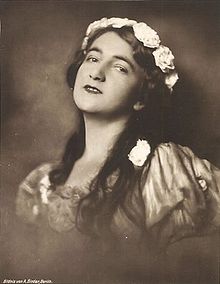Olga Desmond

Olga Desmond , née Olga Antonie Sellin, (born November 2, 1890 in Allenstein , East Prussia , † August 2, 1964 in Berlin ) was a German dancer and actress .
Life
Olga Desmond grew up in Berlin-Kreuzberg . She studied acting and earned her living as a model for artists and painters in Berlin . In 1907 she joined a group of artists and appeared as Venus in three-dimensional representations during her nine-month guest performance in the London Pavilion . In Berlin she was a co-founder of the Association for Ideal Culture and gave performances in which she recreated living images based on ancient models. These so-called beauty evenings were banned several times from 1908, as the actors usually posed naked or painted with body paint.
In 1909, their appearances in the Berlin winter garden caused a scandal that even preoccupied the Prussian state parliament . Olga Desmond was so well known that cosmetic products bore her name. Numerous tours took her through Germany and Austria until 1914. In 1908 and 1909 she joined a. a. in the Viennese Varieté Apollo . She married a Hungarian landowner with whom she withdrew to his estate.
From 1916 to 1918 she starred in various films such as soap bubbles , Mary's Sunday robes and Courage to Sin . In the latter she played together with Hans Albers . In 1917 she separated from her husband and returned to the stage; her first appearance was in the theater of the Royal University of Berlin on April 15, 1917. In the same year she appeared in a performance of Carmen in Cologne . She gave dance evenings a. a. in Warsaw , Wroclaw , Katowice . During the First World War she married the second time, this time the textile entrepreneur Georg Pieck.
She continued to perform until 1922 and devoted herself entirely to teaching. One of her best-known students was Herta Feist , who later became a member of the dance group around Rudolf von Laban . Her admirers also included the dancer Lola Bach , who caused a sensation in the early 1920s with her naturalistic ballet. By the late 1920s, demand for Olga Desmond's dance style declined. Her statuesque dance style was now considered outdated: the expressive dance of younger dancers such as Anita Berber , Valeska Gert or Mary Wigman replaced it.
After 1933 she had increasing problems, also caused by the racial policy of the Nazi regime. Her husband was deported to a concentration camp because of his Jewish descent ; but he managed to flee and leave Germany. Olga Desmond took over his studio for stage equipment.
Until her death in 1964, Olga Desmond managed to get by as a cleaning lady in East Berlin . To make a living, she sold postcards and souvenirs from her time as a dancer.
Filmography
- 1915: Nocturno
- 1915: Lisa, the cigarette maker
- 1915: Soap bubbles (Director: Heinrich Bolten-Baeckers )
- 1917: The Cricket (Direction: Heinrich Bolten-Baeckers)
- 1917: Postcard model (Director: Heinrich Bolten-Baeckers)
- 1917: Mary's Sunday robe
- 1918: The courage to sin (Director: Robert Leffler )
- 1918: life for life
- 1918: The Flying Dutchman (Director: Hans Neumann )
- 1919: Goddess, prostitute and woman (Director: Walter Schmidthässler )
literature
- Jörn E. Runge, Olga Desmond. Prussia's naked Venus , Steffen Verlag, Friedland 2009, ISBN 978-3-940101-53-2
- Olga Desmond: Rhythmography. Dance notation as a basis for self-study of dance , Fritz Böhme, Leipzig, 1919
- Brygida M. Ochaim, Claudia Balk: Variety dancers around 1900. From sensual intoxication to modern dance, exhibition by the German Theater Museum in Munich, October 23, 1998– January 17, 1999. , Stroemfeld, Frankfurt / M. 1998, ISBN 3-87877-745-0
- Gerhard Eberstaller: Circus and Varieté in Vienna , Youth and People, Vienna 1974, ISBN 3-7141-6087-6
Web links
- Literature by and about Olga Desmond in the catalog of the German National Library
- Olga Desmond in the Internet Movie Database (English)
- Olga Desmond at filmportal.de
- How God created them in: Der Tagesspiegel of March 31, 2009
| personal data | |
|---|---|
| SURNAME | Desmond, Olga |
| ALTERNATIVE NAMES | Sellin, Olga Antonie (maiden name); Pieck, Olga (married name) |
| BRIEF DESCRIPTION | German dancer and actress |
| DATE OF BIRTH | November 2, 1890 |
| PLACE OF BIRTH | Allenstein , East Prussia |
| DATE OF DEATH | 2nd August 1964 |
| Place of death | Berlin |
